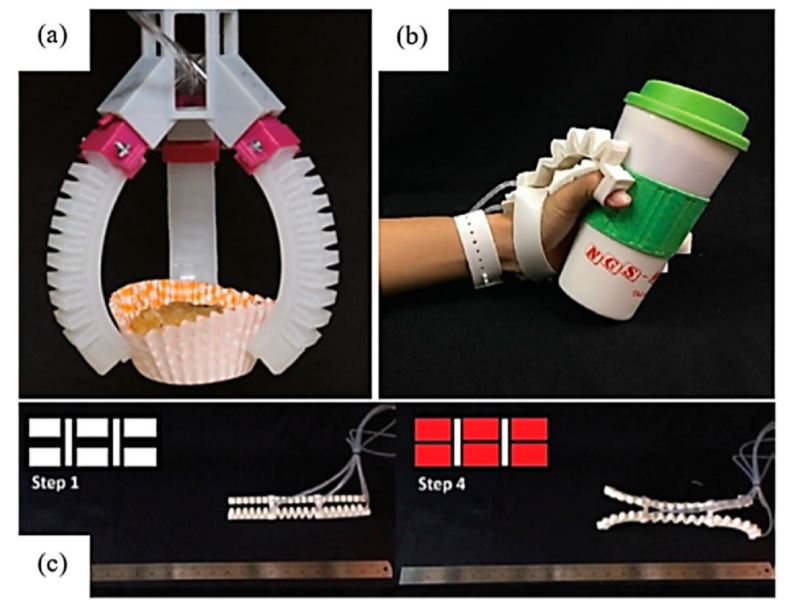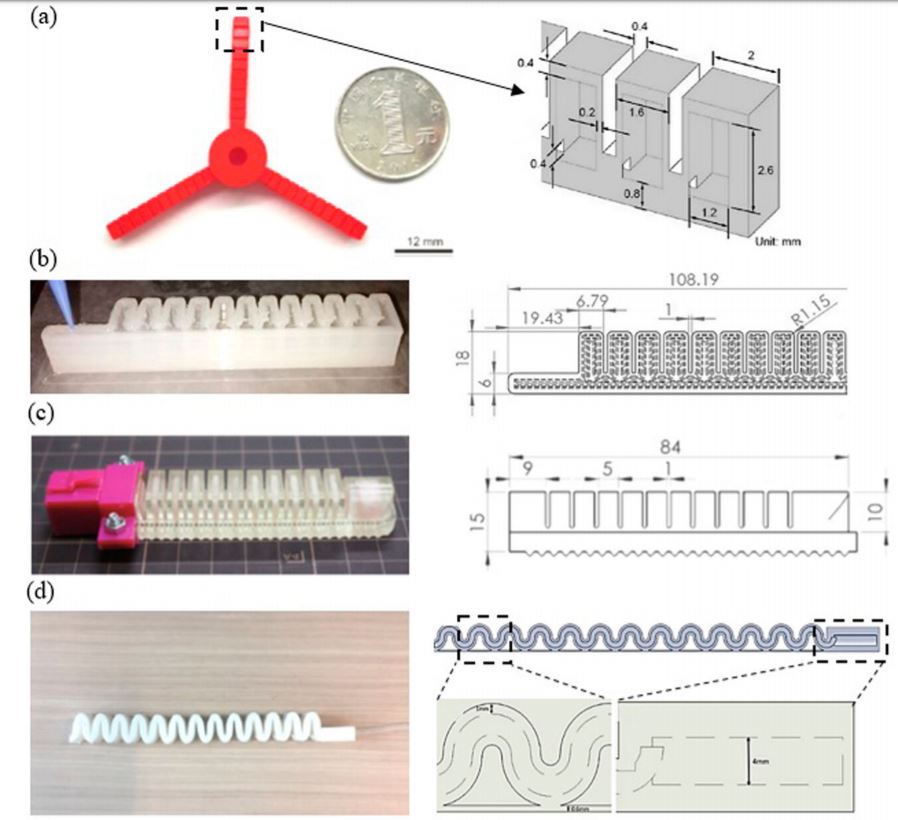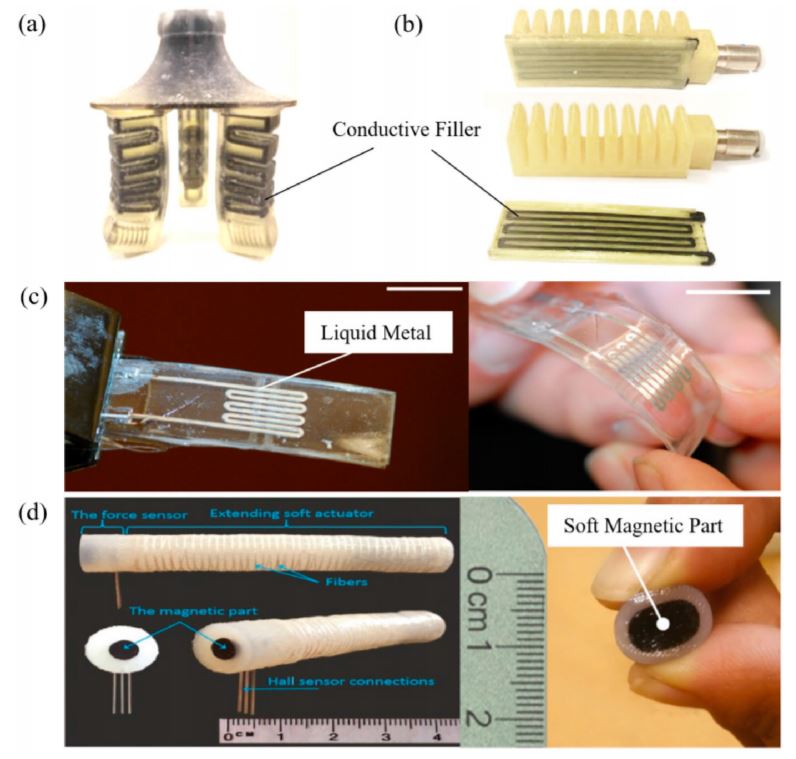Although 3D printing of actuators is a relatively new field of research, interest in the area has grown due to the potential applications of highly customizable, programmable, small scale actuators in micro/mesoscale robotics., including 3D printed hair-like actuators. A common area of research has been into soft actuators for possible industrial applications, where various 3D printing technologies – FDM, DLP, SLS, inkjet, Direct Ink Writing (DIW) and customized SLA platforms, have been used to build multi-material actuators with improved performance, functionality, design flexibility, and manufacturing efficiency.

Soft Actuator industrial gripper applications. Image Courtesy of Virtual and Physical Prototyping 21 Journal
Traditional manufacturing methods for miniature actuators in soft robotics, molding and soft lithography, were limited—and 3D printing has brought several advantages over them. With 3D printing, the inherent design freedom means actuators can be customized at the very small scale easily and can even be designed to accurately mimic bio-inspired architectures. Applications have now advanced to include 4D printing, as researchers from Deakin University and Nottingham Trent University have established in this study.
Published in the Visual and Physical Prototyping journal in July, the study applies 4D printing/3D printing technologies in fabricating Soft bending-type Pneumatic Actuators (SPA), that respond to changes in air pressure. These 4D/3D printed actuators are made using elastomers and are able to deliver a range of motions, such as bending, twisting, rotating, rolling, jumping, in response to simple changes in air pressure.
These actuators are superior to traditional robots in industrial applications such as food packaging, fruit harvesting, space exploration or non-invasive surgery, and provide improved properties in flexibility, lightweight, amplitude and repeatability of motion, ease and cost-effectiveness in fabrication among others. Such 4D/3D printed fabrication methods could also potentially allow for the integrated manufacturing of embedded electronics including sensors (resistive, capacitive, chemical or biological) in elastomeric materials to provide control mechanisms for such miniaturized SPAs.
4D/3D printing enables the development of such high-resolution microscale functionalities for microscale applications although it comes with its own set of challenges, as the study notes,
“Miniaturising and scaling down the 3D/4D printed SPAs are highly desirable, particularly by adding the micrometer-size functionalities for practical applications in the manipulation of microscale delicate objects, e.g. cells. Yet, such feature should be scalable in all the key components of the SPAs, including the integrated sensors, flexible electronics, and controllers. However, miniaturising the SPAs is constrained by the resolution of 3D printers and challenges in 3D printing such as avoidance of microscale voids and channels.”
DIW, an extrusion-based 3D printing technology using photocurable resins, was used to fabricate a programmable bio-inspired SPA with tunable mechanical properties. The fabrication approach using DIW had advantages over FDM, SLA, SLS, inkjet, and DLP – producing few voids, required variable stiffness and fatigue properties, higher strength and elongation at break. New approaches to 4D printing SPA’s have developed self-exciting vibration capabilities, or incorporated bellow-type and embedded fibre into the 3D printed elastomer matrix. In terms of sustainability, 3D printed SPA’s could be designed using recyclable materials to have lower environmental impact, with optimized parameters to reduce its carbon footprint and waste.
Such research has opened up a wide range of possibilities in the design, automated fabrication, modeling and control of 4D printed SPAs, and with further improvements in materials, will guide the way to the next generation in soft robotic actuators that will enable better performance, customization, new applications, cost-efficiency, and sustainability while also making human-robot interactions safer than ever before.
Subscribe to Our Email Newsletter
Stay up-to-date on all the latest news from the 3D printing industry and receive information and offers from third party vendors.
Print Services
Upload your 3D Models and get them printed quickly and efficiently.
You May Also Like
Consolidation in AM: How 2025 Is Shaping the Industry’s New Normal
The first half of 2025 has been marked by a clear shift in the additive manufacturing (AM) industry. Companies are no longer just focused on developing new tech by themselves....
Etsy Design Rule Change Reduces Selection of 3D Printed Goods
Online marketplace Etsy has implemented a rule change requiring all 3D printed goods on the site to be original designs. The update to the site’s Creativity Standards states, ¨Items produced using...
U.S. Congress Calls Out 3D Printing in Proposal for Commercial Reserve Manufacturing Network
Last week, the U.S. House of Representatives’ Appropriations Committee moved the FY 2026 defense bill forward to the House floor. Included in the legislation is a $131 million proposal for...
Transforming From Tourist to Native: Duro CEO Michael Corr Explains Why the Company Rebuilt its PLM Software on AI
In these early innings of the AI boom, many market analysts have expressed concern that AI spend has gotten too far ahead of the technology’s proven ability to deliver significant...


































